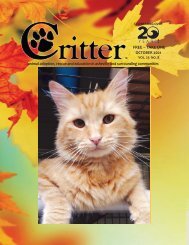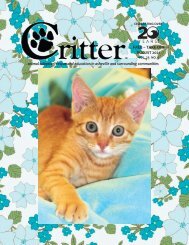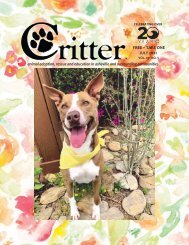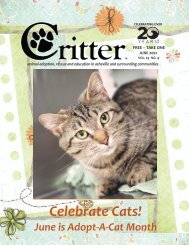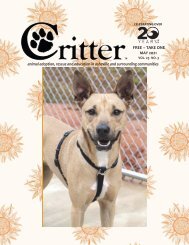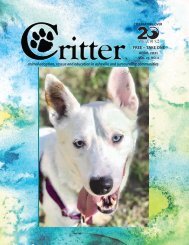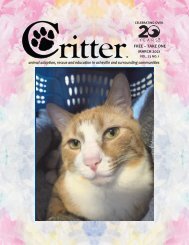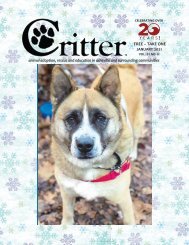Create successful ePaper yourself
Turn your PDF publications into a flip-book with our unique Google optimized e-Paper software.
What You Can Do to Keep<br />
Birds Safe and Happy<br />
Up to 1 billion birds may be killed annually in North<br />
America from colliding with windows. Some birds die on<br />
impact while others are stunned and may fly away.<br />
However, even those who fly away may die later from<br />
internal hemorrhaging and brain swelling or because their<br />
injury and disorientation made them more susceptible to<br />
predation.<br />
Birds fly into a window because they don't know it's a<br />
window. When they see the average window they see the<br />
reflection of trees or sky and think<br />
they can fly through. Sticking a few<br />
stickers or hawk silhouettes on the<br />
glass won't solve the problem;<br />
birds are agile fliers and they'll<br />
perceive that they can fly between<br />
the stickers. But there are things<br />
that you can do reduce the risks.<br />
1. Use taut exterior window<br />
"bug" screens and leave them up<br />
year-round. Screens break up the<br />
reflection and help cushion the<br />
blow and reduce injury if a bird<br />
does hit the window.<br />
2. Apply CollidEscape<br />
(collidescape.org) to the outside of<br />
your windows — an easy-to-apply<br />
vinyl window film that reduces<br />
reflections on the outside of the<br />
window while allowing viewers from inside to see out.<br />
3. Place vertical exterior tape strips on the glass. Strips<br />
must not be set more than 10 centimeters (3.9 inches)<br />
apart. You can also paint patterns on the outsides of<br />
windows with soap or tempera paint (which can be wiped<br />
off with a sponge but will not be washed away by rain).<br />
You can find stencils and tempera paint at art and craft<br />
supply stores.<br />
4. Install frosted or etched windows with less reflective<br />
surface area. This can be done with new windows, while<br />
craft etching kits are available for existing windows.<br />
5. Create movement that can help birds avoid windows.<br />
For example, hang ribbons or other material in strips no<br />
more than 5 centimeters apart on the outside of windows<br />
for the full width of the glass. If you like hawk silhouettes,<br />
make them from aluminum or wood and hang them by a<br />
chain or rope from an overhang.<br />
6. Use external sun shades or awnings to minimize<br />
reflection and transparency of windows.<br />
7. Keep drapes and blinds closed whenever possible to<br />
reduce the illusion that birds can fly through the window.<br />
8. Position houseplants and flowers away from windows<br />
where they cannot be seen from outside to reduce the<br />
likelihood that birds will see them as sources of shelter or<br />
food.<br />
9. Strategically place bird feeders and baths to reduce<br />
collisions. Keep birdbaths and feeders closer than 3 feet<br />
from the window or farther than 20 feet away. If the birds<br />
are very close to the window, they will not build up<br />
sufficient speed for an injury if they fly at the window, and<br />
if they are much farther away they will be more likely to<br />
avoid the window or recognize it as part of the house.<br />
10. If putting in new windows, angle the glass downward<br />
so it does not reflect the sky and trees.<br />
Habitat loss is the single greatest threat to birds,<br />
outweighing building collisions, domestic cat predation,<br />
hunting and capturing for the pet trade.<br />
You can help offset some of these threats and<br />
contribute to wildlife conservation by creating habitats in<br />
your backyard and community, and getting the whole<br />
family involved. It won't take much effort — the following<br />
tips for creating habitats for birds are relatively simple and<br />
immediately impactful.<br />
• Provide nesting sites.<br />
Planting a variety of native trees<br />
and shrubs provides optimal<br />
protection and nesting sites for<br />
birds.<br />
• Diversity is key. One of the<br />
most important features for birds is<br />
structural diversity, with shrubs and<br />
herbaceous plants that grow under<br />
trees and plants at different heights<br />
and groupings.<br />
• Dead trees have a purpose.<br />
Birds love dead trees and limbs. As<br />
long as dead trees and limbs do<br />
not pose a human safety concern,<br />
leave them. They provide habitat<br />
for birds such as woodpeckers and<br />
bluebirds who utilize tree holes for<br />
nests. Dead limbs also provide<br />
optimal "lookout" posts for birds.<br />
• Cats vs. birds. Keep cats indoors, especially during<br />
the bird breeding season (generally spring and summer)<br />
when young birds are most at risk as they are learning<br />
to fly.<br />
• Stop mowing. Or at least set aside some "no-mow"<br />
areas of your yard. Many songbirds nest close to the<br />
ground in grass and "weeds." Leaving tall grass areas will<br />
help birds such as goldfinches, quail and towhees. You<br />
also will save on mowing time, expense and pollution.<br />
• Create a water source. Wild birds need a continuous<br />
supply of fresh, clean water all year long. Look for a basin<br />
that can be cleaned easily and has a gentle slope so birds<br />
can wade into the water. The bowl should be no more<br />
than 1 to 3 inches deep. Keep birdbaths at least 15 feet<br />
from other feeding areas. Place them near shrubs or trees<br />
for quick escape from predators. Having perching space<br />
nearby helps birds to sit and preen after bathing. Keep<br />
water clear of algae, mud or droppings by replacing it<br />
every two to three days.<br />
• Consider the birds and the bees. Help out bees and<br />
provide these pollinators with a variety of flowering plants<br />
that have overlapping flowering periods. Planting clumps<br />
of native flowers will attract more pollinators. But avoid<br />
using insecticides and herbicides, especially when flowers<br />
are in bloom. (If you are successful in attracting a diverse<br />
collection of birds to your garden, you will no longer need<br />
insecticides and herbicides.) Different birds specialize in<br />
eating different insects, while others set their sights on<br />
weed seeds. For example, goldfinches devour thistle<br />
seeds, and black phoebes are experts at catching flying<br />
insects.<br />
CRITTER MAGAZINE • JANUARY 2022 • PAGE 11





